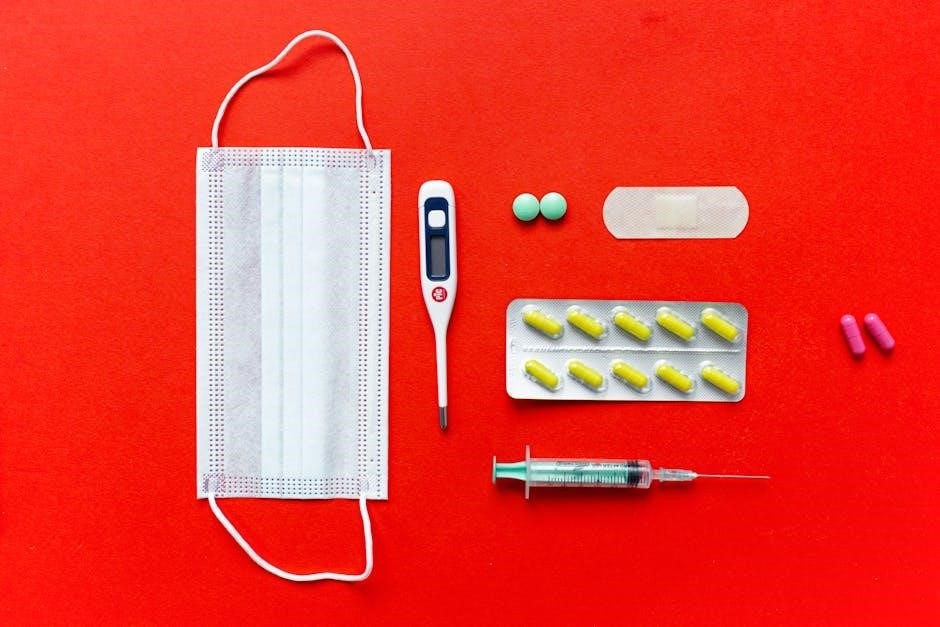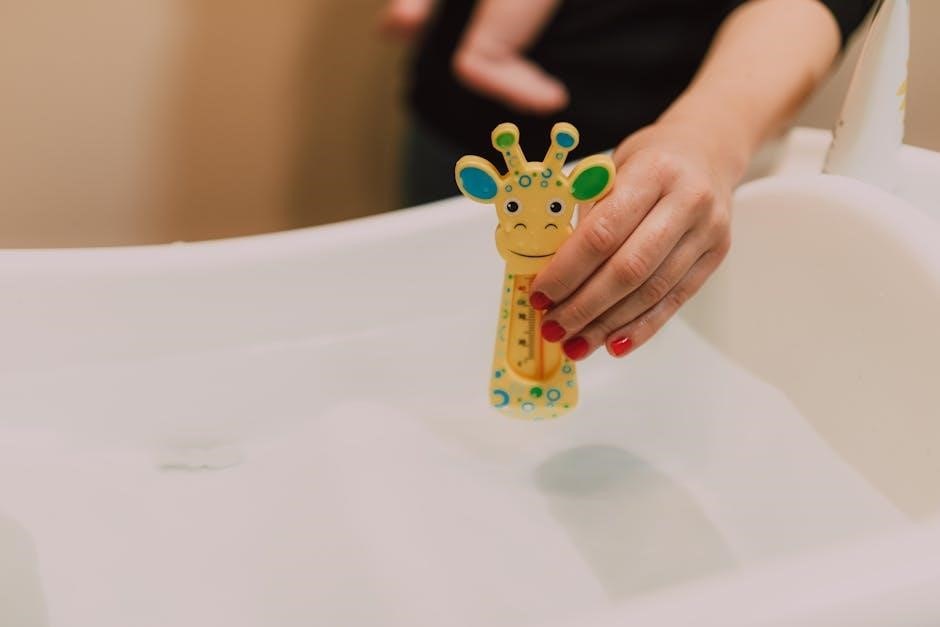Safety 1st Thermometer Instructions: A Comprehensive Guide
Welcome to your comprehensive resource for using Safety 1st thermometers! This guide offers detailed instructions, tips, and troubleshooting for various models, ensuring accurate temperature readings for your little one’s health monitoring.
Safety 1st thermometers are designed with your child’s comfort and your peace of mind in mind. They are valuable tools for parents, offering a range of options to suit different needs and preferences when monitoring a child’s temperature. From rapid read thermometers to forehead scanners, Safety 1st provides user-friendly solutions for accurate readings.
This guide provides comprehensive instructions for using Safety 1st thermometers, ensuring correct usage and accurate results. We’ll explore various models, proper techniques, and helpful tips for temperature taking. Understanding how to effectively use these thermometers empowers parents to confidently monitor their child’s health and well-being.
Whether you’re a new parent or simply looking for a refresher, this guide will equip you with the knowledge to confidently use your Safety 1st thermometer. Accurate temperature readings are crucial, and we’re here to make the process simple and straightforward.

Types of Safety 1st Thermometers
Safety 1st offers a variety of thermometers to suit your needs. These include rapid read, forehead, and 2-in-1 models, each designed for easy and accurate temperature taking.
Rapid Read 3-in-1 Thermometer
The Safety 1st Rapid Read 3-in-1 Thermometer offers versatile temperature taking through oral, rectal, or underarm methods. This thermometer provides a fast reading, quickly indicating whether your child has a fever. Its flexible tip ensures comfort during rectal readings, complemented by an over-insertion gauge for added safety and confidence.
The Rapid Read 3-in-1 Thermometer is designed for ease of use and accuracy, making it a reliable tool for parents. Remember to clean the thermometer thoroughly after each use.
With its rapid reading capability, parents can swiftly assess their child’s temperature and take appropriate action. This thermometer is an essential item for every family’s health kit. It comes with a warranty for a year.
Simple Scan Forehead Thermometer
The Safety 1st Simple Scan Forehead Thermometer offers a quick, non-invasive way to measure temperature. Position it one inch from the center of the forehead, press the measure button, and receive a reading in just one second. The thermometer also features a fever alert icon, instantly indicating if the temperature is normal or high.
The Simple Scan Forehead Thermometer includes a night mode, allowing temperature checks without disturbing your child. Additionally, it can measure the temperature of food and bath water. This thermometer prioritizes simplicity and convenience, making it perfect for parents.
It’s designed for ease of use, offering quick and accurate readings. It operates using a 3-volt battery which may need replacing from time to time.
Quick Read 2-in-1 Thermometer
The Safety 1st Quick Read 2-in-1 Thermometer offers versatile temperature taking. Choose between oral or underarm modes for a convenient experience. With a fast 8-second reading, you’ll quickly know if your child has a fever. Its flexible tip ensures comfort during use, particularly for young children.
This thermometer is designed for ease of use and accuracy. The user manual provides detailed instructions for optimal performance. The device is compact and easy to handle, making it a practical addition to any family’s health kit. Always read all warnings, instructions, and notations before using this product.
Its 2-in-1 functionality allows for adaptable temperature monitoring. It utilizes battery power, so be sure to check your battery.

How to Use a Safety 1st Forehead Thermometer
Using a Safety 1st forehead thermometer is simple. Position it correctly on the forehead, following the provided guidelines, for a quick and accurate temperature measurement. Always refer to the user manual.
Proper Positioning for Accurate Readings
Achieving accurate temperature readings with a Safety 1st forehead thermometer heavily relies on proper positioning. Ensure the thermometer is held approximately one inch away from the center of the forehead. Align the device so that it is perpendicular to the forehead surface, avoiding any angle that could skew the results.
For models with LED guidance, line up the red dots directly on the forehead, ensuring they overlap. This indicates the correct distance and alignment for an accurate reading. Keep the forehead clean and dry, as sweat or moisture can interfere with the sensor’s ability to detect temperature effectively.
Avoid taking readings immediately after a bath, exercise, or exposure to extreme temperatures, as these factors can temporarily affect body temperature. Always consult the user manual for specific instructions related to your thermometer model; Correct positioning minimizes errors, providing reliable insights into your child’s health.

Taking Temperature with a Safety 1st 3-in-1 Thermometer
This section outlines how to accurately take a temperature using the Safety 1st Rapid Read 3-in-1 Thermometer, which offers oral, rectal, and underarm measurement options for versatile use.
Oral, Rectal, and Underarm Use
The Safety 1st 3-in-1 thermometer offers versatile temperature-taking options. For oral use, ensure the thermometer is placed under the tongue, instructing the child to keep their mouth closed until a beep indicates completion. Sanitize the thermometer thoroughly before and after each oral reading to prevent germ transmission.
For rectal use, particularly with infants, gently insert the thermometer about half an inch into the rectum. Lubricate the tip with petroleum jelly for comfort and accurate results. Hold the thermometer steady until the reading is complete.
For underarm use, place the thermometer firmly in the armpit, ensuring skin contact. Keep the arm pressed against the body until the beep sounds. Note that underarm readings may be slightly lower than oral or rectal readings. Always clean the thermometer after each use, regardless of the method.
Understanding Fever Alerts and Readings
Safety 1st thermometers often feature fever alert systems, indicated by a visual icon or color-coded display. Familiarize yourself with your specific model’s fever range. A normal temperature typically falls between 97°F and 100.3°F (36.1°C and 37.9°C), but this can vary slightly.
Elevated readings may trigger a fever alert, signaling a potential health concern. Consult your pediatrician for guidance if your child exhibits fever symptoms. Keep in mind that a single temperature reading should be considered alongside other symptoms. A fever is a sign that the body is fighting an infection.
Always document temperature readings, the time they were taken, and any accompanying symptoms. This information will be valuable when discussing your child’s health with a medical professional. Accurate readings are essential for effective care.

Battery Replacement Guide
When your Safety 1st thermometer displays a low battery indicator, it’s time for a replacement. Typically, these thermometers use a small, round battery, such as a CR2032. To begin, locate the battery compartment, usually on the back or side of the device.
Use a miniature Phillips head screwdriver to carefully loosen the battery cover screw. Remove the cover and the old battery. Note the battery’s orientation before removing it.
Insert the new battery, ensuring the correct polarity (+/-). Replace the battery cover and tighten the screw securely. Dispose of the old battery responsibly. After replacement, test the thermometer to ensure it powers on and functions correctly. Refer to the manual for detailed instructions and safety precautions.
Where to Find Safety 1st Thermometer Manuals
Locating the manual for your Safety 1st thermometer is essential for proper usage and troubleshooting. The primary source for these manuals is the official Safety 1st website. Navigate to the “Support” or “Product Manuals” section, where you can search using the model number found on your thermometer.
ManualsLib is another valuable resource, offering a wide range of Safety 1st thermometer manuals in PDF format. Online retailers like Amazon and Walmart, where you may have purchased the thermometer, often provide links to the product manual on the product page.
Additionally, check the packaging your thermometer came in, as it may contain a physical copy of the manual. If all else fails, contact Safety 1st customer service for assistance in obtaining the correct manual.